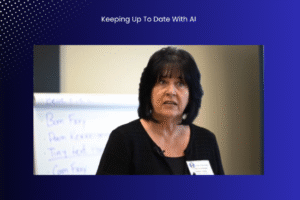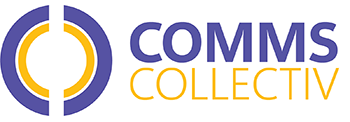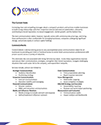CollectivNews
Welcome to a monthly round-up of information relevant
to comms professionals and everyone interested in the fractional model.
June 2025

It’s Gonna Take a Lot More Than a Company All-Hands
By Kate Bachman
I was having a conversation with another comms leader recently about internal communications and how to deal with things that cause chaos among employees — like layoffs, mergers and acquisitions, etc.
Internal Comms is complicated, particularly as organizations scale or go through any sort of change. The toolbox of communicating with employees usually includes things like (hopefully) a thoughtful narrative, paired with a lot of tactics or channels:
• Company town halls/all hands
• “Ask me anything” leadership meetings
• Internal newsletters
• Some sort of internal site or app
• Slack or messaging channels
Despite all of the above and more, there seems to always be a pervasive level of drama: the unquenchable need for more information from employees, the execs’ fear that information will be leaked, etc. It’s an overall distrust between the employee base and anyone with a leadership title and no amount of messages or channels seem to solve it.
These issues — which directly impact productivity and the ability to hit targets — only get worse the more change or growth that occurs within an organization and the more perceived instability that exists in the market. (aka: everything going on now)
So, how do you fix this?
Answer: Train people managers and leaders in communication skills. Specifically in active listening and de-escalation.
(It’s worth mentioning that there is also a lack of training around empathy, though it’s already a buzzword that most assume is some innate quality or a mystical trait that is always perfect, as long as it’s in the room. It’s not. Correctly applying empathy in a work setting is still a skill.)
There is a long-standing issue that has become markedly worse in the past decade or so, where companies stopped providing skills training to people managers. Sure, new managers may get trained on company-specific workflows or ‘norms,’ maybe they read a book like ‘The Five Dysfunctions of a Team” or learn how executive dynamics work. Those are all helpful, but when was the last time you saw training on how to not be awkward or how to ask questions of an irate employee?
The Enduring Lie About Trickle Down Communications
A lot of organizations think that as long as select, accurate information is cascaded down, everything will be fine. But is it ever? The very premise of that is, in fact, problematic:
• It assumes all people managers understand everything the same way and are all on the same page in delivering information (be so for real – when has this ever happened?)
• It sparks a parent-child type relationship between leadership and employees which is rife with issues because work relationships are not familial.
• It ignores departmental or geographic subcultures because people usually don’t have the bandwidth to even consider these factors, let alone customize communications for them.
Cascading information through any multi-layered org therefore becomes a messed up game of telephone, where people’s happiness and livelihood, and a business’s success are all on the line. It becomes particularly detrimental if managers aren’t skilled in communication basics.
Some Tidbits to Consider
Active Listening
• Listening ≠ waiting to talk
• It’s not about you, regardless of any turmoil you’re going through
• Don’t be weird when you reflect back or paraphrase to confirm understanding
• Put your phone out of sight (not just face down on the table). If on zoom, don’t be looking around the room or at another screen. Turn off your slack notifications.
De-escalation
• Doing this well requires active listening, so revisit the above first
• Be careful not to use dismissive phrases, body language, or facial expressions
• Maintain inner and outer calm: This involves emotional mastery of yourself and being able to project a collected, balanced, and solutions-oriented state, even if you’re stressed out, don’t have all the information, or disagree with a direction.
Leaders, if your goal is sustained productivity, clarity, and executional excellence, then strong internal communications is a must. Achieving that means investing in training your people. Start by asking your head of comms for help – they know how to do this. (And if you don’t have one, maybe consider a fractional comms leader to come in and assess or help with this).
Bonus Thought: in addition to great communication skills, leaders also need to know who the real influencers on the team are. The people who everyone goes to for “the scoop” or who people look to for honesty and comfort in stressful situations. These people can be anyone in an org because it usually depends on their personality or some other intangible like ‘a vibe.’ But managers and leaders should — without ego — know who these individuals are and work to have trusting relationships with them.
Kate Bachman is the Chief Communications Strategist & Owner of Way and Words, fractional communications leader, and valued member of the CommsCollectiv talent pool.

The Strategy Behind “Just Enough” Executive Support
As you know, CommsCollectiv has been championing the value of fractional leadership. We’ve seen firsthand how this model gives companies access to senior-level talent without the overhead or rigidity of a full-time hire. In today’s business climate — where agility, budget discipline, and results matter more than ever — the idea of “just enough” executive support isn’t a compromise. It’s a smart strategy.
A recent article in The Observer echoes what we’ve been saying: more seasoned executives are stepping into fractional roles, and more companies are embracing them.
The article highlights a powerful shift in the workforce. By 2028, more than half of U.S. workers could be freelancers, driven by the appeal of greater flexibility, increased earnings, and the opportunity to shape their own careers. This trend is moving beyond traditional freelance roles into the C-suite, giving rise to “fractional leadership” — a model where companies bring in experienced executives on a part-time basis to meet specific needs. The demand for this model is growing, particularly in the face of economic uncertainty, talent shortages, and evolving work norms like hybrid and remote environments.
The article also emphasizes how fractional executives provide strategic value to both small and large businesses, delivering high-level expertise without the cost or commitment of full-time hires. It also underscores how this shift benefits executives, allowing them to design a more fulfilling work-life balance while staying engaged in meaningful leadership roles. As companies seek agility and adaptability in a fast-changing market, the future of work — especially at the leadership level — is increasingly fractional.
The fractional model is built for impact — bringing in the right expertise at the right time to drive progress. As the article makes clear, the demand for flexible, high-caliber leadership isn’t slowing down. And at CommsCollectiv, we’re proud to be at the forefront of this shift.
(Photo above from A New Executive Exit Strategy: The Rise of the Fractional C-Suite, May 2025)

AI Is Moving Fast and Your Brand Can’t Afford to Blink
AI Is Moving Fast. Your Brand Can’t Afford to Blink.
We all see it and feel it, the AI landscape is evolving at breakneck speed. Anthropic, Google, OpenAI, and Meta are rolling out revolutionary tools that are reshaping how we create, communicate, and connect. For brand and communications leaders, this isn’t a trend to monitor — it’s a strategic shift to navigate. Here’s what’s new and why it matters.
Claude 4 by Anthropic: Research, Writing, and Brand Consistency — at Scale
Anthropic’s Claude 4 is built to handle complex tasks, from research and writing to structured data analysis. One standout feature: Claude can process extremely large inputs (like entire brand guidelines, multi-page reports, or lengthy call transcripts) without losing context. This makes it ideal for automating tasks like drafting content, summarizing sentiment, or generating PR reports that stay aligned with brand voice.
And with features making coding more accessible and Google Workspace integration, Claude can even search your internal docs and the web at once. It’s a communications co-pilot with guardrails. Its “constitutional AI” design minimizes the risk of off-brand or harmful outputs, which is critical in high-stakes messaging.
Google’s AI Blitz: Gemini, Veo, and the Rise of AI Agents
Google’s recent I/O 2025 announcements were a clear signal: they’re building for businesses. The Gemini 2.5 Pro model is excellent at reasoning and coding. With its expanding context window, it can handle big-picture thinking across large documents and datasets.
Then there’s Veo 3, which generates full videos with music, dialogue, and motion from a simple prompt. Or Project Mariner, which can automate online research and repetitive web tasks. The Gemini AI Ultra Plan ($249.99/month) unlocks access to tools like Deep Think, designed for solving complex business challenges. I tested Flow with a simple prompt: create a video of a communications leader, someone in her 50s, leading a workshop. Do not include words. Here are two results edited into one video.
For communications teams, this means faster content generation, smarter customer segmentation, and campaign assets (like visuals and summaries) created on demand. But remember: Accuracy still needs a human check.
OpenAI’s Momentum: Visuals, Workflows, and Conversational Search
OpenAI now supports more than 400 million users and continues to integrate AI deeper into work. Its Codex tool helps automate technical workflows, especially for internal platforms or dashboards. But what’s especially relevant for comms: the latest ChatGPT-4o can now create visuals (like charts and infographics) and conduct real-time web searches with linked sources, cutting down time spent researching and designing.
For communications leads, this simplifies tasks like pulling competitive insights, generating branded visuals, or prepping internal reports. But OpenAI’s data retention practices still raise privacy questions. Make sure your use of the tool aligns with internal policies and compliance standards.
Meta’s AI Push: Engagement, Speed, and Control
Meta is embedding AI across Facebook, Instagram, and WhatsApp through Meta AI, built on the open-source Llama 4 model. Tools like AI-suggested replies, image generation, and campaign support are becoming baked into everyday social interactions.
Brands can now quickly localize content, personalize engagement, and create high-volume assets for platforms where audiences already live.
The catch? How much control are you willing to give up? Meta’s tools may boost productivity, but they also raise questions around data ownership, transparency, and ethical training sources. It’s a broader question every comms lead needs to ask about any AI platform: Who controls the data? Who owns the content? And is your organization okay with that?
Why This Matters for Brands and Comms Leads
The AI boom isn’t theoretical, it’s operational. Claude 4 helps automate research-heavy workflows while preserving tone. Google’s tools speed up production and analysis. OpenAI brings together search and visuals in a seamless interface. Meta brings scale and reach through social.
Together, these platforms are redefining how we work and they demand critical thinking. Made up information, weak transparency, and overreliance on automation can lead to missteps if unchecked.
What You Can Do Next
✅ Experiment Thoughtfully
Try Claude for structured content workflows, Gemini for video, or Meta AI for scalable social but start with low-risk projects.
✅ Prioritize Trust
Use tools with strong safeguards. Claude’s “constitutional AI” framework is one example of AI designed with brand risk in mind.
✅ Stay Informed
Sign up for trusted newsletters. Follow experts like Rebecca Gonzales, Allie Miller and Frank Shaw on LinkedIn. AI changes constantly and your strategy should too.
✅ Audit Every Tool
Review how each provider handles your data. Build policies that keep control in your hands, not the platforms’.
Bottom line
AI is not a future strategy, it’s a current one. The comms teams that engage intentionally, stay curious, and protect trust will define how their brands show up in this AI-driven world.


